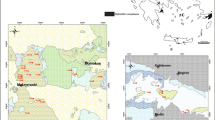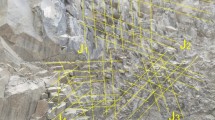Abstract
Seepage from the body and foundations of dams is one of the most important design parameters highly influenced by permeability. Also, permeability is one of the basic parameters for designing grout curtains, preventing water from escaping from the foundation and avoiding negative seepage pressures in borrow materials used for grouting. In this work, rock mass classification of a rock foundation dam site was carried out using the rock mass rating (RMR) and geological strength index (GSI) systems. This study was mainly conducted to evaluate permeability and groutability at the Nargesi dam site in Iran using secondary permeability index (SPI), joint hydraulic aperture (JHA) and Lugeon tests. Also, the dam foundation was evaluated by pressure tests (WPTs) that indicated the need for a grout curtain below the dam foundation. The rock mass quality of the samples obtained via the SPI in conjunction with the drill core jointing degree acts as a useful reference for ground treatment design. The dam foundation groutability was zoned according to an SPI classification point view. There is no direct relationship between the JHA values and water take in all the sections, but a direct relation is observed in some boreholes. Such a relationship can be attributed to joint characteristics such as persistence, etc. The results of this work revealed, except for a few cases, there is a reasonable correlation between secondary permeability index (SPI) and rock quality designation (RQD) values. Based on these results, a grout type and composition was suggested for construction of the grout curtain.














Similar content being viewed by others
References
Ajalloeian R, Moein F (2009) Evaluation of damsites groutability using secondary permeability index, rock classification (Case Studies). Am J Appl Sci 6:1235–1241
Barton N (2008) Workshop on rock engineering for drill- and blast and TBM tunneling and important aspects of rock mass behavior, Iran
Barton N, Bandis SC, Bakhtar k (1985) Strength, deformation and conductivity of rock joints. Int J Rock Mech Min Sci Geomech Abstr 22(3):40–121
Bell G (2000) Engineering properties of soil and rocks, 4th edn. Blackwell Science, Oxford, p 482
Bieniawski ZT (1989) Engineering rock mass classification. Wiley, New York
Dalmalm T (2004) Choice of grouting method for jointed hard rock based on sealing time predictions, Division of Soil and Rock Mechanics Department of Civil and Architectural Engineering, Royal Institute of Technology, Stockholm
Deer DU (1964) Technical description of rock cores for engineering purpose. Rock Mech Rock Eng 1:17–22
Deer DU (1989) Rock quality designation (RQD) after twenty years. US Army Corps of Engineering Contact Report GL-89-1, Water ways Experiment Station, Vicksburg, 67 p
Deere DU (1968) Geological considerations. In: Stagg RG, Zienkiewicz DC (eds) Rock mechanics in engineering practice. Wiley, New York, pp 1–20
Deere DU (1982) “Cement-bentonite grouting for dams”. American Society of Civil Engineers, Geotechnical Engineering Specialty Conference on Grouting, New Orleans, February 10–12, pp 279–300
Ewert FK (1985) Rock grouting with emphasis on dam sites. Springer, Berlin, p 428
Ewert F-K (1997a) Permeability, groutability and grouting of rocks related to dam sites. Part 1: grouting examples and ground water flow in rock. Dam Eng 8(1):31–77
Ewert F-K (1997b) Permeability, groutability and grouting of rocks related to dam sites. Part 2: permeability testing by means of water pressure tests. Dam Eng 8(2):123–176
Ewert F-K (1997c) Permeability, groutability and grouting of rocks related to dam sites. Part 3: hydrogeological regime around dams and reservoir. Dam Eng 8(3):215–248
Ewert F-K (1997d) Permeability, groutability and grouting of rocks related to dam sites. Part 4: groutability and grouting of rock. Dam Eng 8(4):271–325
Foyo A, Sánchez MA (2002) Permeability tests for rock masses. A proposal for a new expression for the equivalent Lugeon unit (ELU). Dam Eng 8(3):199–218
Foyo A, Sánchez MA, Tomillo Carmen (2005) A proposal for a secondary permeability index obtained from water pressure tests in dam foundations. Eng Geol 77:69–82
Ghobadi MH, Khanlari GR, Djalali H (2005) Seepage problems in the right abutment of the Shahid Abbaspour Dam, southern Iran. Eng Geol 82:119–126
Gurocak Z, Alemdag S (2011) Assessment of permeability and injection depth at the Atasu dam site (Turkey) based on experimental and numerical analyses. Bull Eng Geol Environ 64:400–409
Hoek E, Kaiser PK, Bawden WF (1995) Support of underground excavations in hard rock. Balkema, Rotterdam
Houlsby AC (1990) Construction and design of cement grouting. Wiley, New York, 442 pp
Houlsby AC (1992) Construction and design of cement grouting. A guide to grouting in rock foundations. Wiley, New York
Karagqzel R, Kilic R (2000) The effect of the alteration degree of ophiolitic melange on permeability and grouting. Eng Geol 57:1–13
Kocbay A, Kilic R (2006) Engineering geological assessment of the Obruk dam site (Corum, Turkey). Eng Geol 87:141–148
Kutzner TC (1996) Grouting of rock and soil. Balkema, Rotterdam, p 271
Nonveiller E (1989) Grouting, theory, and practice. Elsevier, Amsterdam, pp 250
Nusier OK, Alawneh AS, Malkawi AH (2002) Remedial measures to control seepage problems in the Kafrein Dam, Jordan. Bulletin Eng Geol Environ 16:145–152
Priest SD (1985) Hemispherical projection methods in rock mechanics. George Allen & Unwin, London
Priest P (1993) Discontinuity analysis for rock engineering. Chapman & Hall, London, p 473
Priest SD, Hudson YA (1976) Discontinuity spacing in rock. Int J Rock Mech Min Sci Geomech Abstr 13:135–148
Rasouli Maleki M (2011) Study of the engineering geological problems of the Havasan Dam, with emphasis on clay-filled joints in the right abutment. Rock Mech Rock Eng 44:695–710. doi:10.1007/s00603-011-0165-2
Romanov D, Gabrovsek F, Dreybrodt W (2003) Dam sites in soluble rocks: a model of increasing leakage by dissolution widening of fractures beneath a dam. Eng Geol 70:17–35
Sadeghiyeh S, Hashemi M, Ajalloeian R (2012) Comparison of permeability and groutability of Ostur dam site rock mass for grout curtain design. Rock Mech Rock Eng 603:283–286
Shibata L, Lida R, Matsumoto N (1981) Procedures for the investigations of permeability and seepage control in soft rock foundations for dams, International Symposium on Weak Rock, Tokyo, vol I, pp 503–508
Snow DT (1968) Rock fractures spacings, openings and porosities. Am Soc Civ Eng Proc 94:73–91 (SM 1)
Turkmen S (2003) Treatment of the seepage problems at Kalecik Dam (Turkey). Eng Geol 68:159–169
Uromeihy A, Barzegari G (2007) Evaluation and treatment of seepage problems at Chapar-Abad Dam, Iran. Eng Geol 91:219–228
Uromeihy A, Farrokhi R (2011) Evaluating groutability at the Kamal-Saleh Dam based on Lugeon tests. Bull Eng Geol Environ 64:382–387
Verfel J (1989) Rock grouting and diaphragm wall construction. Elsevier, Amsterdam
Warner J (2004) Practical handbook of grouting; soil, rock, and structures. Wiley, New Jersey
Weaver K (1991) Dam foundation grouting. American Society of Civil Engineers, New York
Author information
Authors and Affiliations
Corresponding author
Rights and permissions
About this article
Cite this article
Azimian, A., Ajalloeian, R. Permeability and groutability appraisal of the Nargesi dam site in Iran based on the secondary permeability index, joint hydraulic aperture and Lugeon tests. Bull Eng Geol Environ 74, 845–859 (2015). https://doi.org/10.1007/s10064-014-0675-8
Received:
Accepted:
Published:
Issue Date:
DOI: https://doi.org/10.1007/s10064-014-0675-8




